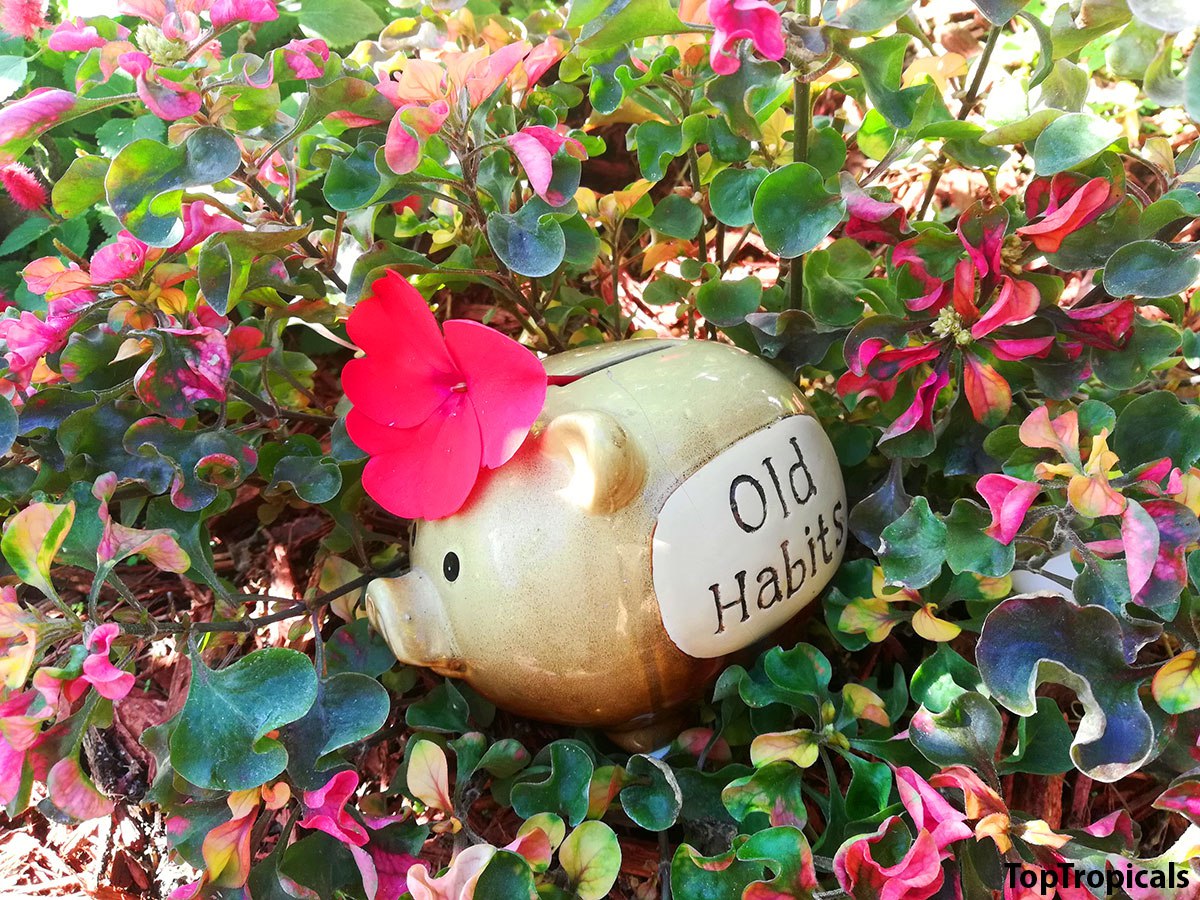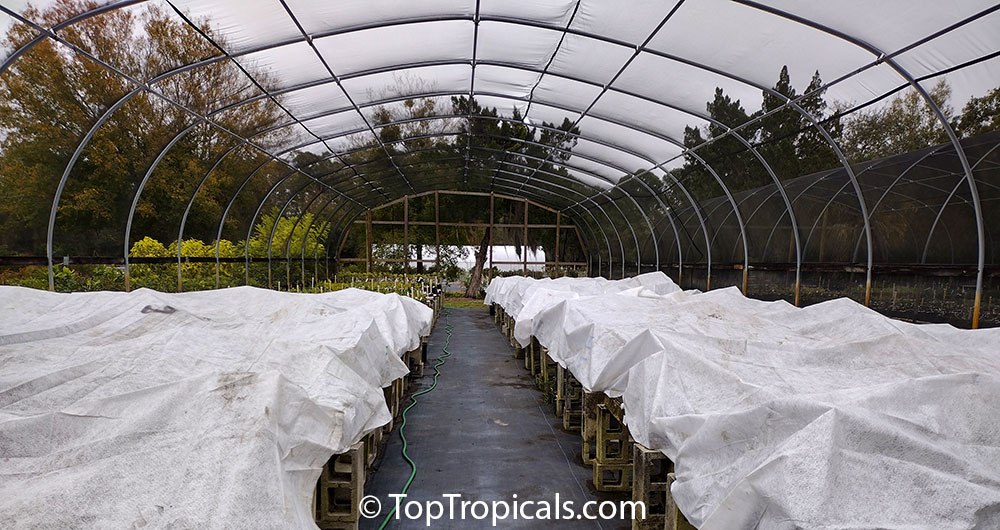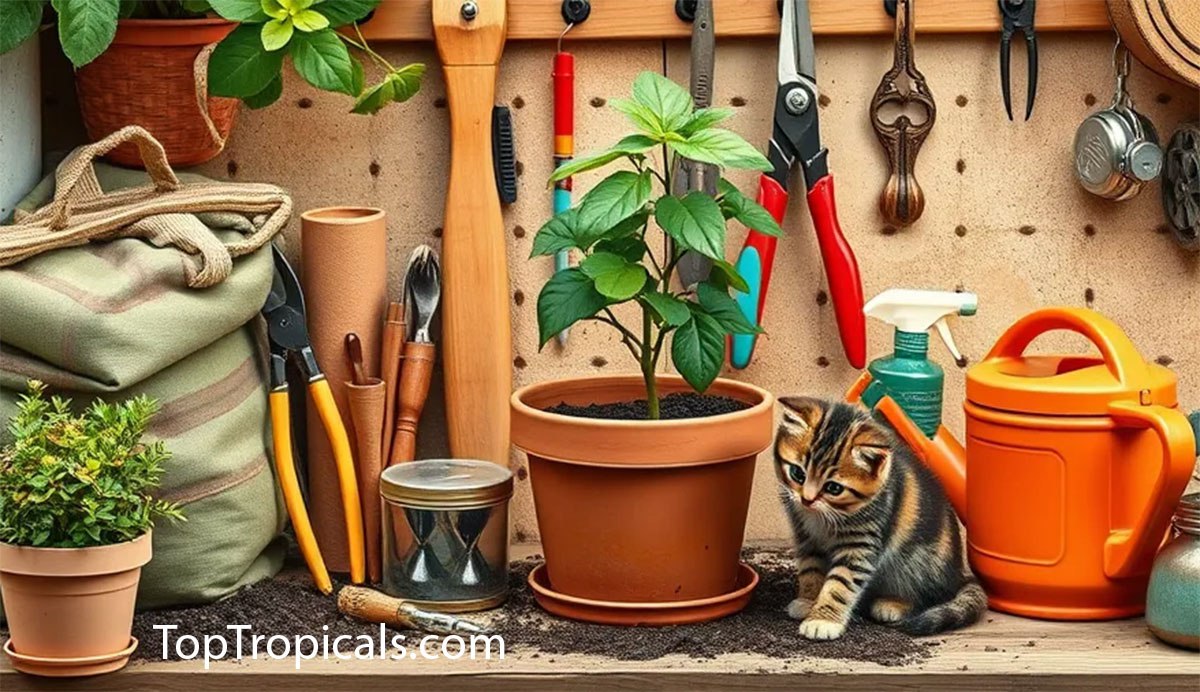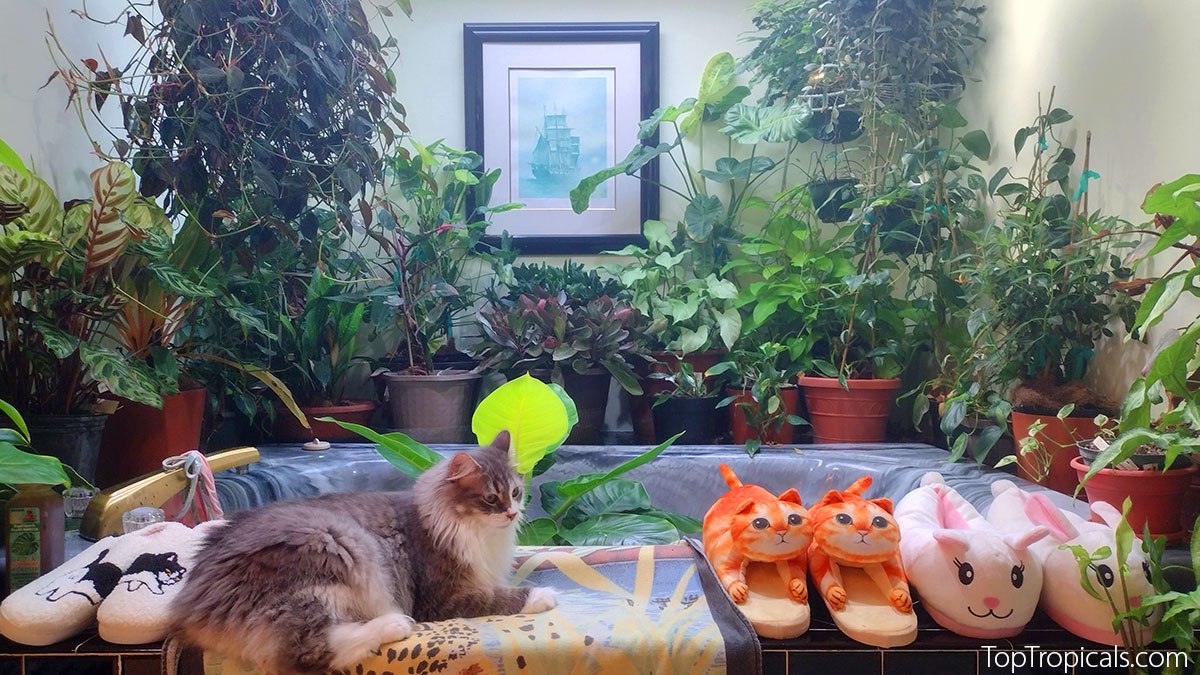Garden Blog - Top Tropicals
How to overwinter tropical plants indoors
❄️ How to overwinter tropical plants indoors
❓ I have two Mandevillas that thrived on my balcony all summer. Now that cold weather is approaching, I've moved them indoors to bright spots, but they're dropping and wilting leaves. How can I keep them healthy until spring? Should I fertilize them? Can Mandevillas grow indoors year-round?
✔️ First, keep in mind that the plants we call "indoor plants" or "house plants" are all tropical. However, not all tropical plants are suitable for indoor living. Some, especially shade-loving ones, thrive in indoor conditions, which is why we refer to them as "house plants" (philodendrons, monsteras, calatheas, peperomias, and many others, including some succulents). Others are less adaptable to the lower light and humidity typical of indoor spaces, but with a little extra care, you can overwinter them inside and move them back outdoors in spring. Mandevillas are no exception! Even tropical trees, including fruit trees, can tolerate a few months indoors if given the right conditions for semi-dormancy. Below are the 10 key tips for successfully overwintering tropical plants indoors.
Find out the secrets of overwintering in our next post ⬇️
🛒 Shop Indoor plants
#How_to
🔴 Join 👉 TopTropicals
❓ I have two Mandevillas that thrived on my balcony all summer. Now that cold weather is approaching, I've moved them indoors to bright spots, but they're dropping and wilting leaves. How can I keep them healthy until spring? Should I fertilize them? Can Mandevillas grow indoors year-round?
✔️ First, keep in mind that the plants we call "indoor plants" or "house plants" are all tropical. However, not all tropical plants are suitable for indoor living. Some, especially shade-loving ones, thrive in indoor conditions, which is why we refer to them as "house plants" (philodendrons, monsteras, calatheas, peperomias, and many others, including some succulents). Others are less adaptable to the lower light and humidity typical of indoor spaces, but with a little extra care, you can overwinter them inside and move them back outdoors in spring. Mandevillas are no exception! Even tropical trees, including fruit trees, can tolerate a few months indoors if given the right conditions for semi-dormancy. Below are the 10 key tips for successfully overwintering tropical plants indoors.
Find out the secrets of overwintering in our next post ⬇️
🛒 Shop Indoor plants
#How_to
🔴 Join 👉 TopTropicals
New Year with New Plants: how to choose from 17 Tropical Paradise Resolutions
📌 New Year with New Plants: how to choose from 17 Tropical Paradise Resolutions
✍️ "A garden is never so good as it will be next year..." - Thomas Cooper.
⚡️ As we step into a fresh new year, it's the perfect time to think about what exciting, special, and life-changing plants we can add to our gardens. The days are getting longer, and spring is just around the corner, so now's the time to make a plan and prepare for the season ahead. Let's take small steps each year to create the garden of our dreams. This winter, consider these fun resolutions:
#How_to #Quotes
🔴 Join 👉 TopTropicals
✍️ "A garden is never so good as it will be next year..." - Thomas Cooper.
⚡️ As we step into a fresh new year, it's the perfect time to think about what exciting, special, and life-changing plants we can add to our gardens. The days are getting longer, and spring is just around the corner, so now's the time to make a plan and prepare for the season ahead. Let's take small steps each year to create the garden of our dreams. This winter, consider these fun resolutions:
💋Hang a bird feeder and install a rain barrel- 💋Order some tropical plant seeds for an early start
- 💋Ask your grandparents about their favorite garden plants
- 💋Build a raised bed for succulents
- 💋Plant a fruit tree or two to have some crop this year
- 💋Start a compost pile
- 💋Switch to organic fertilizers and plant boosters
- 💋Fill empty spaces with flowering trees, shrubs, and vines
- 💋Add butterfly attractors to your garden
- 💋Provide water for bees and butterflies to help them thrive and pollinate your fruit trees
- 💋Get a bonsai starter to try bonsai art
- 💋Enjoy meals outside as often as you can
- 💋Teach a child how to plant a tree
- 💋Plant berry-bearing shrubs like Tropical Cherries to feed the birds
- 💋Rake up leaves for winter mulch
- 💋Add a few exotic plants to your indoor collection or container garden
- 💋Share plants as gifts all year long
- 🚩🚩🚩🚩 Happy gardening in 2025!
#How_to #Quotes
🔴 Join 👉 TopTropicals
How to protect tropical plants in Winter
How to protect tropical plants in Winter
Strengthen Plant Hardiness:
#How_to
🔴 Join 👉 TopTropicals
- Winter Care Tips for Tropical Plants
- · Cut watering: Reduce watering to prevent root rot. Cold + wet = dead roots.
- · Water before frost: Thirsty plants are more vulnerable. Water them before a cold night to prevent damage.
- · Wind protection: Wind is more harmful than temperature drops. Plant near structures like houses or trees for shelter.
- · Prepare for long cold periods: If cold weather lasts for hours, use all available protection, including Christmas lights and propane heaters.
- · Don't use dry fertilizer in winter: Heavy fertilizing encourages tender growth, which is more susceptible to cold damage. Sunshine Boosters liquid fertilizers are safe to use year around as their intake is controlled by reduced watering.
- · Use fabric covers, not plastic: Plastic can cook plants in the sun, while fabric allows better ventilation.
- Prepare for Cold Nights:
- · Wrap plants: On cold nights, cover individual plants or trees with sheets or blankets to shield them from wind chill.
- · Use Christmas lights: A simple string of lights can add extra warmth, protecting your plants during frosty nights.
- · Use propane heaters: For added warmth in a larger area, place a propane heater near your plants. Make sure to follow safety guidelines and keep the heater at a safe distance from flammable materials. This can help maintain a few extra degrees of warmth, especially in more open garden spaces or temporary greenhouses. Always ensure proper ventilation to avoid harmful gas buildup.
- · Affordable winter greenhouse: For large plant collections, you don't need an expensive greenhouse. A mobile carport with plastic or fabric covering, costing around $200, can house up to 100 plants!
- Key Factors for Survival:
- · Cold duration: Tropical plants can survive brief cold spells but long durations, even above freezing, can be deadly.
- · Wind-chill: Wind chill can be harsher than the temperature itself.
- · Exposure: Southern-facing slopes hold heat longer, making them ideal for your plants.
- · Humidity: Proximity to lakes or oceans can create a milder micro-climate.
- · Gradual temperature Drops are safer. Plants adjust better to slow temperature changes than sudden cold blasts. Gradual cooling allows plants to prepare, reducing the risk of damage.
Strengthen Plant Hardiness:
· Health and maturity: Well-established, healthy plants are more cold-hardy.- · Boost plant immunity: Use products like SUNSHINE-Epi to improve cold resistance. Apply it before and during cold snaps to protect your plants.
- · Healthy plant is hardy. Make sure to fertilize your plants on regular basis - healthier and stronger plants are more cold hardy
#How_to
🔴 Join 👉 TopTropicals
How to Grow Jackfruit: Practical Guide
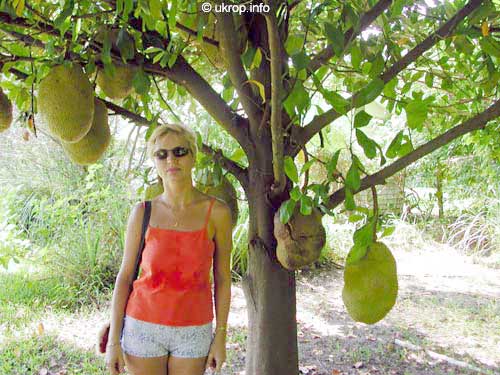
Jackfruit (Artocarpus heterophyllus) tree

Jackfruit (Artocarpus heterophyllus) fruit

Jackfruit (Artocarpus heterophyllus) fruit at the base of the tree
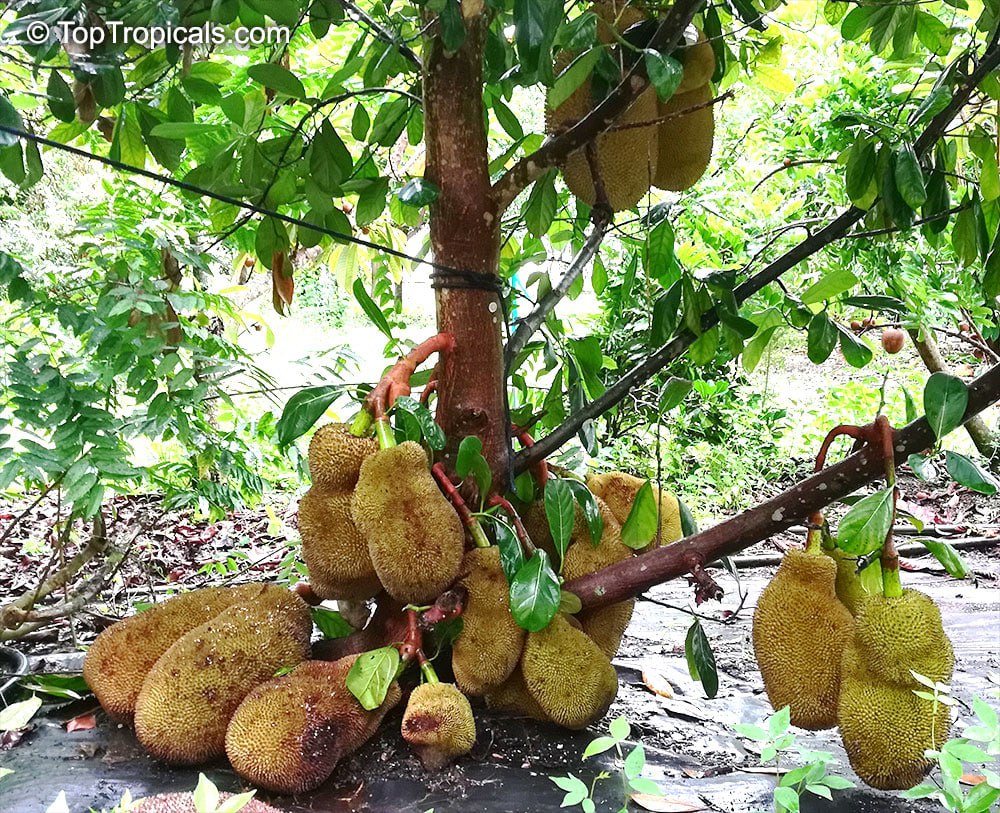
Jackfruit (Artocarpus heterophyllus) fruit at the base of the tree
How to Grow Jackfruit: Practical Guide
🍈 Jackfruit facts
👍 Jackfruit trees grow fast and fruit abundantly with proper care, making them an exotic addition to tropical fruit collections.
📚 From previous posts:
The largest tree-borne fruit in the world
How to grow the biggest fruit on Earth
🛒 Plant your own Jackfruit
#Food_Forest #How_to
🔴 Join 👉 TopTropicals
- 🍈 Jackfruit (Artocarpus heterophyllus) is a tropical tree that produces the largest fruit in the world, weighing up to 80 pounds and reaching 36 inches in length. The trees thrive in frost-free, humid climates with plenty of sunlight. They require well-draining soil rich in organic matter and regular watering to flourish. Despite their reputation as ultra-tropical, mature Jackfruit trees can tolerate light frost for a few hours without significant damage. Additionally, they can be grown in containers in colder areas with proper care and pruning.
- 🍈 What Climate is Essential for Growing Jackfruit Trees?
- 🍈 How Often Do Trees Need Fertilizing, and What is the Best Type of Feed?
- 🍈 How Important is Pruning, and When is the Right Time to Prune?
- 🍈 Key Tips for Successful Jackfruit Production
Jackfruit trees require a tropical or subtropical climate, with temperatures ideally between 60-95°F. While young trees are frost-sensitive, mature trees can withstand light frost for short periods. However, cold winters can reduce fruit production. Frost-free temperatures are crucial for optimal growth and fruiting.
Jackfruit trees are heavy feeders. Fertilizing them regularly is key to their health and productivity. During the active growing season (spring to fall), apply a balanced dry fertilizer once a month. Liquid amino-acid-based fertilizers, such as Sunshine Boosters, can be used year-round with every watering. These fertilizers help maintain healthy growth and encourage abundant fruiting. Supplement with organic matter like compost, manure, or peat moss to enrich the soil.
Pruning is essential for maintaining a manageable tree size and promoting healthy fruit production. Jackfruit trees produce fruit at the base of the trunk, allowing them to be pruned annually to a height of 7-12 feet. This practice not only makes harvesting easier but also encourages more fruiting. Prune after the fruiting season or in late fall to remove excess growth and shape the tree. Regular pruning also improves air circulation and reduces the risk of disease.
- · Climate: Ensure frost-free temperatures and adequate humidity.
- · Soil: Use well-draining soil enriched with organic matter.
- · Watering: Maintain consistent soil moisture without waterlogging.
- · Pruning: Keep the tree under 7-10 feet for easier management and better yield.
- · Fertilizing: Apply balanced fertilizers and supplements regularly.
🍈 Jackfruit facts
- · The fruit consists of large, edible bulbs of yellow, sweet, banana-pineapple-flavored aromatic flesh.
- · Seedlings start fruiting within 3-4 years, with fruit ripening 4-6 months after flowering.
- · A mature tree can produce up to 200 pounds of fruit annually.
- · For colder regions, growing Jackfruit in containers is an option, provided the tree is regularly pruned and topped.
👍 Jackfruit trees grow fast and fruit abundantly with proper care, making them an exotic addition to tropical fruit collections.
📚 From previous posts:
The largest tree-borne fruit in the world
How to grow the biggest fruit on Earth
🛒 Plant your own Jackfruit
#Food_Forest #How_to
🔴 Join 👉 TopTropicals
Unlock the Beauty of Nature at Home!
🌺 Unlock the Beauty of Nature at Home!
Transform your living space into a tropical paradise with our stunning selection of tropical plants and fruit trees (#Food_Forest) at TopTropicals. Each plant is a gateway to vibrant colors and fresh scents, bringing life and joy to your home.
🌻 But that’s not all! Join our channel for exclusive tips on #How_to nurture your new green companions.
From watering schedules to sunlight needs, we provide everything you need to become a tropical plant whisperer!
🔴 Subscribe now for expert advice: 👉 TopTropicals
Transform your living space into a tropical paradise with our stunning selection of tropical plants and fruit trees (#Food_Forest) at TopTropicals. Each plant is a gateway to vibrant colors and fresh scents, bringing life and joy to your home.
🌻 But that’s not all! Join our channel for exclusive tips on #How_to nurture your new green companions.
From watering schedules to sunlight needs, we provide everything you need to become a tropical plant whisperer!
🔴 Subscribe now for expert advice: 👉 TopTropicals
How much water is too much?
💧 How much water is too much?
🌴 "Always over-water your plants: just improve their soil drainage!" - Murray Corman, horticulturist, rare tropical fruit tree expert.
Read full article.
👍 What makes an issue for you? Over water or forgetting to water? Share in comments⬇️
📚 Learn more about potting soil
🛒 Shop soil mixes
#How_to
🔴 Join 👉 TopTropicals
🌴 "Always over-water your plants: just improve their soil drainage!" - Murray Corman, horticulturist, rare tropical fruit tree expert.
🐸 One of the most common challenges in tropical plant care, including houseplants, is overwatering, particularly in container gardening. So, how much water is too much?
🐸 Surprisingly, water itself isn't harmful to plants, no matter how generous your watering is. The real issue is poor drainage, which leads to stagnation and bacterial buildup, ultimately causing root rot.
🐸 If you've traveled to places like Hawaii or explored tropical jungles, you might have noticed plants thriving between rocks with minimal soil, receiving a near-constant fine mist of rain. Conversely, swamps support very few trees - only bog or water plants adapted to wet conditions can survive there. The lesson? It's not the water, it's the growing medium!
🐸 The Solution: For potted plants, always use a high-quality potting mix with excellent drainage properties. This should include ample "soil conditioners" such as perlite, vermiculite, and pine bark. At our nursery, we use a professional soil mix called Abundance.
Read full article.
👍 What makes an issue for you? Over water or forgetting to water? Share in comments⬇️
📚 Learn more about potting soil
🛒 Shop soil mixes
#How_to
🔴 Join 👉 TopTropicals
Index of TopTropicals Telegram Channel
🗂 Index of TopTropicals Telegram Channel
Follow these tags to find your interests:
#Butterfly_Plants - Butterfly attracting plants.
#Container_Garden - Plants suitable for container garden and indoor culture.
#Fertilizers - All the truth about fertilizers, plant food supplements, and our recommendations for different types of plants.
#Food_Forest - Fruit trees, Spice plants, and Edibles.
Including: #Avocado, #Mango, #Papaya, #Guava, #Jackfruit, #Loquat
📖 #Fun_Facts - interesting plant facts and legends.
🌳 #Hedges_with_benefits - Practical approach to your landscape and how to properly select showy and useful plants for your yard.
♍️ #Horoscope - Plant Horoscopes and Cat Horoscopes. Did you know that cats also have their Zodiac signs?
🛠 #How_to - Q&A about growing plants, tropical garden lifehacks.
👀 #Nature_Wonders - Unusual, amusing, outrageous, bizarre plants...
🐈 #PeopleCats - our Favorite PeopleCats (and some PeopleDogs, too).
🌸 #Perfume_Plants - Fragrant plants and perfume trees.
✍️ #Quotes - Interesting quotes.
#Recipes - Exotic recipes for tropical fruit and edibles.
💊 #Remedies - Medicinal plants.
☁️ #Shade_Garden - Plants suitable for low light conditions.
🌼 #Trees - Spectacular flowering tropical trees.
🏆 #Win - Contests, Sweepstakes, and other specials.
Join and share with friends👇🏵
TopTropicals
Follow these tags to find your interests:
#Butterfly_Plants - Butterfly attracting plants.
#Container_Garden - Plants suitable for container garden and indoor culture.
#Fertilizers - All the truth about fertilizers, plant food supplements, and our recommendations for different types of plants.
#Food_Forest - Fruit trees, Spice plants, and Edibles.
Including: #Avocado, #Mango, #Papaya, #Guava, #Jackfruit, #Loquat
📖 #Fun_Facts - interesting plant facts and legends.
🌳 #Hedges_with_benefits - Practical approach to your landscape and how to properly select showy and useful plants for your yard.
♍️ #Horoscope - Plant Horoscopes and Cat Horoscopes. Did you know that cats also have their Zodiac signs?
🛠 #How_to - Q&A about growing plants, tropical garden lifehacks.
👀 #Nature_Wonders - Unusual, amusing, outrageous, bizarre plants...
🐈 #PeopleCats - our Favorite PeopleCats (and some PeopleDogs, too).
🌸 #Perfume_Plants - Fragrant plants and perfume trees.
✍️ #Quotes - Interesting quotes.
#Recipes - Exotic recipes for tropical fruit and edibles.
💊 #Remedies - Medicinal plants.
☁️ #Shade_Garden - Plants suitable for low light conditions.
🌼 #Trees - Spectacular flowering tropical trees.
🏆 #Win - Contests, Sweepstakes, and other specials.
Join and share with friends👇🏵
TopTropicals
10 common mistakes to avoid with mail order plants
⚠️ 10 common mistakes to avoid with mail order plants
Continued from previous post 👆
Always inspect new plants for pests. Shipping stress can lead to infestations, so a close check is vital.
🌷By avoiding these mistakes and following the planting instructions included with your order, you'll be on the right path to creating your tropical paradise. Take care of your new plant, and it will thrive, rewarding you with vibrant growth for years to come.
#How_to
🔴 Join 👉 TopTropicals
Continued from previous post 👆
⏺6. Placing the plant in the wrong environment
⏺7. Not trimming damaged branches.
⏺8. Expecting immediate growth
⏺9. Fertilizing too soon
⏺10. Not checking for pests
It's important to give your plant the right temperature, light, and humidity based on its natural habitat. We grow tropical plants. They won't survive in areas with freezing temperatures.
Transit can cause minor damage to leaves or branches. Trimming these parts can help the plant recover faster.
Plants need time to adjust after the trip. Give them a chance to settle for a few weeks before expecting new growth or blooms.
Do not fertilize your plant right after arrival. Let it get established first - usually a few weeks - before adding fertilizer to avoid stressing the plant.
Always inspect new plants for pests. Shipping stress can lead to infestations, so a close check is vital.
🌷By avoiding these mistakes and following the planting instructions included with your order, you'll be on the right path to creating your tropical paradise. Take care of your new plant, and it will thrive, rewarding you with vibrant growth for years to come.
#How_to
🔴 Join 👉 TopTropicals
How to add flowering vines to the landscape
Urechites lutea (Pentalinon luteum) - Yellow Mandevilla
🔍 How to add flowering vines to the landscape
🎥 Urechites lutea (Pentalinon luteum) - Yellow Mandevilla
🛒 Shop flowering vines
#Hedges_with_benefits #How_to
🔴 Join 👉 TopTropicals
- 🍀 Vines, by their nature, are almost always climbers. There are also some that make good hanging flower vines for your baskets hanging under trees or on the front porch.
- 🍀 Some vines are also in the fruit category. The Passiflora is a beautiful perennial climbing vine that has very showy flowers and then a fruit that can be eaten off the vine or made into a wonderful juice. It would make a nice fast growing vine for a fence or trellis. The Barbados Gooseberry also falls into this category.
- 🍀 One of the most popular fast growing flowering vines is the trumpet vine - Allamanda. It is an evergreen vine and will take some cold without damage, although it is still considered a tropical flowering vine. It can be grown as a large shrub or small tree and makes a beautiful focal point in the landscape.
- 🍀 If you have some large trees in your yard, a great climbing vine for shade that also produces a usable product is the Pepper family. Yes, they flower and yes some of them produce pepper that you can use in your kitchen. If you like to know what is in your food, grow your own!
- 🍀 Another perennial, fast growing and evergreen climbing vine is the Monstera. Monsteras will climb the side of a large tree and can produce an edible fruit after a few years. It is very tropical looking, but will take some cool nights as it is protected under the canopy of the tree.
🎥 Urechites lutea (Pentalinon luteum) - Yellow Mandevilla
🛒 Shop flowering vines
#Hedges_with_benefits #How_to
🔴 Join 👉 TopTropicals
10 key tips for successful overwintering of tropical plants indoors
10 key tips for successful overwintering of tropical plants indoors
1. Maximize Light: The more light, the better. There's no such thing as too much indoor light. If windows aren't enough, use LED grow lights, which stay cool and won't dry the air. Rotate plants every few days to prevent uneven leaf loss.
2. Reduce Watering: Less light and cooler temperatures mean plants need less water. Allow the soil to dry between waterings, and avoid overwatering - combination of cold + wet is especially harmful.
3. Maintain Moderate Temperatures: Most tropicals are happy with daytime temperatures around 75F and nights at 50-60F. In sunrooms or greenhouses, some can handle 45F if watering is kept to a minimum.
4. Boost Humidity: Avoid placing plants near heaters or vents that dry the air. Misting daily helps, or place pots on trays filled with water and pebbles to raise humidity around them.
5. Monitor for Pests: Check leaves weekly to catch insect problems early, as pests can cause serious damage or even kill the plant indoors.
6. Fertilize Smart: Use ONLY liquid, amino-acid-based fertilizers like Sunshine Boosters throughout winter; they won't burn roots since their dosage adjusts with reduced watering. Avoid dry, granulated, and EDTA-based fertilizers during winter and dormancy.
7. Use Micro-Nutrients: Along with macro-elements (fertilizers), supplement with micro-elements like Sunshine Superfood and bio-stimulants such as Sunshine Epi to build strong plants with robust immune systems, better able to withstand unfavorable conditions and resist diseases.
8. Hold Off on Pruning: Leaf drop and leggy growth are normal responses to winter. Wait until spring to prune, when new growth starts, to encourage branching and healthy foliage.
9. Don't Repot Yet: During dormancy, roots slow their growth. Repotting too soon risks root rot. Wait until spring when new growth appears to transplant into a larger container. Typically, roots grow in proportion to the above-ground parts.
10. Let Them Rest: Winter is a natural resting period. Avoid forcing growth - your plants will reward your patience with vibrant leaves and flowers when spring returns.
🛒 Shop Indoor plants
#How_to
🔴 Join 👉 TopTropicals
1. Maximize Light: The more light, the better. There's no such thing as too much indoor light. If windows aren't enough, use LED grow lights, which stay cool and won't dry the air. Rotate plants every few days to prevent uneven leaf loss.
2. Reduce Watering: Less light and cooler temperatures mean plants need less water. Allow the soil to dry between waterings, and avoid overwatering - combination of cold + wet is especially harmful.
3. Maintain Moderate Temperatures: Most tropicals are happy with daytime temperatures around 75F and nights at 50-60F. In sunrooms or greenhouses, some can handle 45F if watering is kept to a minimum.
4. Boost Humidity: Avoid placing plants near heaters or vents that dry the air. Misting daily helps, or place pots on trays filled with water and pebbles to raise humidity around them.
5. Monitor for Pests: Check leaves weekly to catch insect problems early, as pests can cause serious damage or even kill the plant indoors.
6. Fertilize Smart: Use ONLY liquid, amino-acid-based fertilizers like Sunshine Boosters throughout winter; they won't burn roots since their dosage adjusts with reduced watering. Avoid dry, granulated, and EDTA-based fertilizers during winter and dormancy.
7. Use Micro-Nutrients: Along with macro-elements (fertilizers), supplement with micro-elements like Sunshine Superfood and bio-stimulants such as Sunshine Epi to build strong plants with robust immune systems, better able to withstand unfavorable conditions and resist diseases.
8. Hold Off on Pruning: Leaf drop and leggy growth are normal responses to winter. Wait until spring to prune, when new growth starts, to encourage branching and healthy foliage.
9. Don't Repot Yet: During dormancy, roots slow their growth. Repotting too soon risks root rot. Wait until spring when new growth appears to transplant into a larger container. Typically, roots grow in proportion to the above-ground parts.
10. Let Them Rest: Winter is a natural resting period. Avoid forcing growth - your plants will reward your patience with vibrant leaves and flowers when spring returns.
🛒 Shop Indoor plants
#How_to
🔴 Join 👉 TopTropicals


